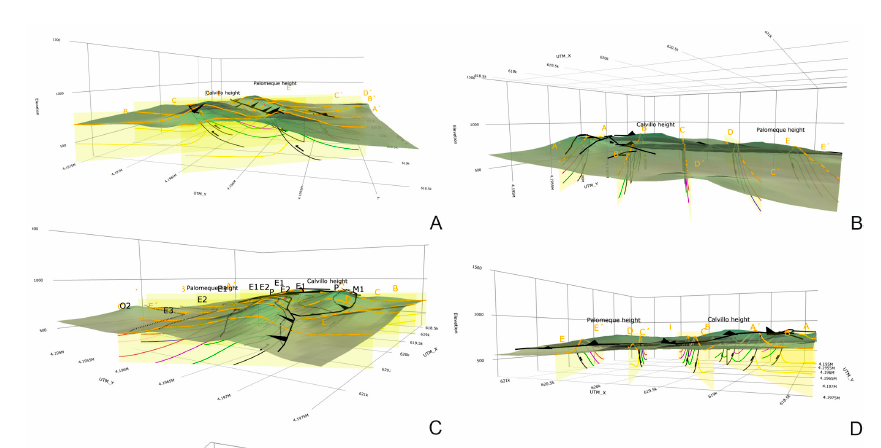Home » Posts tagged 'Malaguide Complex'
Tag Archives: Malaguide Complex
3D Visualization of geological structures using Python: the case study of the Palomeque sheets
The goal of this paper is the construction of computerized 3D visualization of geological structures. Several Python applications have been used to adapt the paper map-based geological classical information to numerical geological maps represented in HTML files. The models include a map with the stratigraphic and structural contacts and symbols, five serial vertical sections, and a geological block diagram, all with real topography. This block diagram made with 2D figures allows a 3D visualization. Palomeque area (Murcia region, southeastern Spain) has been used as a key-case. This area consists of a deformed Upper Cretaceous to Oligocene succession belonging to the Internal Zone Malaguide Complex. The main structure consists of two thrust-fold sheets forming an imbricate system, also affected by a set of strike-slip faults with a sinistral regime. The constructed maps show a good agreement with the published classical geological maps and cross-sections demonstrating the benefits of using these Python applications.

Cite as: Bullejos, M. and Martín-Martín, M. (2023): 3D Visualization of geological structures using Python: the case study of the Palomeque sheets (SE, Spain). Journal of Maps 19, NO. 1, 2282593 https://doi.org/10.1080/17445647.2023.2282593
A Python Application for Visualizing an Imbricate Thrust System: Palomeque Duplex (SE, Spain)
This paper introduces a Python application for visualizing an imbricate thrust system. The application uses the traditional geologic information to create an HTML geological map with real topography and a set of geological cross-sections with the essential structural and stratigraphic elements. On the basis of the high geological knowledge gained during the last three decades, the Palomeque sheets affecting the Cenozoic Malaguide succession in the Internal Betic Zone (SE Spain) were selected to show the application. In this area, a Malaguide Cretaceous to Lower Miocene succession is deformed as an imbricate thrust system, with two thrusts forming a duplex, affected later by a set of faults with a main strike-slip kinematic. The modeled elements match well with the design of the stratigraphic intervals and the structures reported in recent scientific publications. This proves the good performance of this Python application for visualizing the structural and stratigraphic architecture. This kind of application could be a crucial stage for future groundwater, mining, and civil engineering management.

Cite as: Bullejos, M., Martín-Martín, M., 2023. A Python Application for Visualizing an Imbricate Thrust System: Palomeque Duplex (SE, Spain). Geosciences. https://doi.org/10.3390/geosciences13070207
Supplementary Materials: The following supporting information can be downloaded at: https://www. mdpi.com/article/10.3390/geosciences13070207/s1: interactive 3D geological map: 3D_Palomeque_map_sections.html; interactive 3D geological sections: 3D_Palomeque_map_sections.html. Python codes and the detailed instructions to download and run the codes can be found in a GitHub repository at: https://github.com/bullejos/visualizing-an-imbricate-thrust-system.
Sedimentary History and Palaeogeography of the Cenozoic clastic wedges of the Malaguide Complex, Internal Betic Cordillera, Southern Spain
The Cenozoic sedimentary cover of the Malaguide Complex (Internal Betic Cordillera, Spain), in the Almería and Málaga areas, consists of a suite of sedimentary successions from continental and shallow-marine to deep-marine environments. Structural and stratigraphic relations, and petrological and geochemical signatures reveal the sedimentary evolution of the Cenozoic Malaguide Complex (CMC) from pre-orogenic (Palocene-Eocene) to syn-orogenic (Oligocene-Early Miocene) stages.

Sandstones detrital modes of the overall succession are heterogeneous testifying to a multi-source area, marked by exhumation of the Malaguide basement terranes and of the Internal Betic Zone (Alpujárride Complex) in lower position. Pre-orogenic and syn-orogenic strata consist of four main depositional sequences: the Mula Group (Paleocene), the Xiquena Group (Eocene) for the preorogenic successions; and Ciudad Granada Group (Oligocene-Aquitanian) and Viñuela Group (Burdigalian) for the synorogenic successions. Pre-orogenic strata evolve from intra-arenite to hybrid arenites to progressive increase of sandstones in abundance of detrital supply from sedimentary cover of the internal Betic units. The unroofing history of the internal Betic Units, predominantly in the Malaguide Complex, is clearly testified in strata of the synorogenic clastic units, where detrital supply is coming from the Malaguide Complex. Sedimentary lithic fragments were derived from the Mesozoic strata of the Malaguide Complex while metamorphic detritus is related to the Internal Betic Zone basement that was exhumed starting from the Oligocene. Pre-orogenic mudrocks mainly show abundance of calcite and dolomite over quartz and phyllosilicates. Syn-orogenic mudrocks, record an abrupt decrease in calcite and dolomite and an increase of phyllosilicate, quartz and feldspars mainly in the Malaga section. The geochemical signatures attest to a compositional variation of the samples from pre-to-synorogenic successions, with palaeoweathering indices showing moderate values and a weak up-section decrease. The Cenozoic Malaguide Complex played a key role in the geodynamic evolution of the Betic Cordillera, representing the key tectonic element of the western Mesomediterranean domains.

Cite as: Critelli, S., Martín-Martín, M., Capobianco, W., Perri, F., 2021. Sedimentary history and palaeogeography of the Cenozoic clastic wedges of the Malaguide Complex, Internal Betic Cordillera, southern Spain. Mar. Pet. Geol. 124, 104775. https://doi.org/https://doi.org/10.1016/j.marpetgeo.2020.104775
Recent Comments